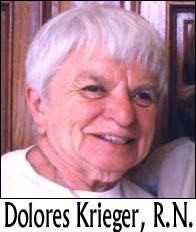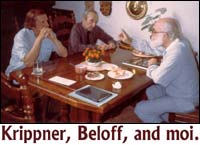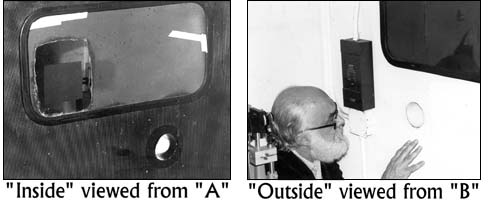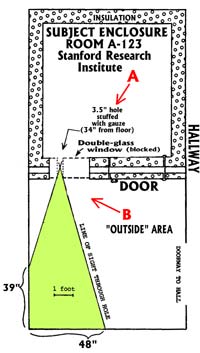
 A couple decades ago in Australia, I was called in to examine the claims of a young chap named John Rainbow. His mentor, who I will decline to name, had constructed a device to demonstrate John's claimed ability to detect whether or not a small current was flowing in a resistor. John did this by waving a small quartz crystal pendulum over the resistor, which was either passing current, or not — depending on the position of a simple flip-flop relay inside the circuit box.
A couple decades ago in Australia, I was called in to examine the claims of a young chap named John Rainbow. His mentor, who I will decline to name, had constructed a device to demonstrate John's claimed ability to detect whether or not a small current was flowing in a resistor. John did this by waving a small quartz crystal pendulum over the resistor, which was either passing current, or not — depending on the position of a simple flip-flop relay inside the circuit box.
It was pretty simple. To begin a trial, the operator would keep a button depressed for a moment or so, then release it. This activated the rapidly oscillating relay, by means of which action the current from a small battery inside was randomly either directed through the resistor, or not. The resistor was clamped in place on the upper surface of the box so that Rainbow could wave his pendulum at it — though there was another advantage to that positioning, as we will see. The box had a meter on its face, in series with the current as it flowed, but another "normally on" button on the box shorted out the meter until it was pressed, whereupon the meter would prove the state of the circuit by either swinging full-scale (showing that the current was "on") or staying at the zero point, resting against the retaining post on the dial.
After John Rainbow had declared whether or not the current was passing through the resistor, that button would be pressed, and the guess would be scored.
In the first set of trials, I merely observed as John obtained results of about 9 correct out of 10 trials. But I noticed that he bent forward very close to the face of the box, and his eyes would look over at the meter, though it was not yet "in the circuit" because its button was not depressed. That made me suspicious, and I soon solved his method. It had nothing to do with the quartz crystal, but everything to do with that meter!
The "normally on" button should have been a perfect bypass for the current, but it as not, quite. It offered a bit of resistance, enough that the meter needle was not completely relaxed against the post, but was very slightly away from it, just a hair's width. When I first was able to call the state of the circuit with the same accuracy as Mr. Rainbow, and then Mr. Rainbow's performance dropped off to 50% after I covered the meter dial with a business card, the case was proved.
We never saw John Rainbow or his mentor, again.
I-gotta-tell-you Department: Our good friend Piero Angela from Italy visited the JREF this last week, and informed me that pharmacies in his country are now offering band-aids (are you seated?) that advertise they're loaded with tachyons to assist the healing process! This mysterious tachyon item is a hypothetical sub-atomic particle that is supposed to travel faster than light. It was first postulated in 1967 by physicist Gerald Feinburg, but Piero and I are of the opinion that it's so elusive that it would be difficult to obtain in sufficient quantities to sell in band-aids.....
 The Washington Post of August 11th ran an article by Chris Mooney, "How Psychic Are You?" "101 Ways of Seeing Yourself; From Archetypes and Chakras to Enneagrams and Sun Signs." To me, one item in the piece stood out of the text particularly strongly. For years now, nurse Dolores Krieger, the discoverer of the quack technique known as "therapeutic touch," has ignored inquiries, letters, calls, and e-mail that we at JREF have sent to her. In effect, she has sequestered herself in her ivory tower and grandly rebuffed all approaches we've made. When someone does get through to this rather strange person, the resultant confusion is evident. Wrote Mr. Mooney:
The Washington Post of August 11th ran an article by Chris Mooney, "How Psychic Are You?" "101 Ways of Seeing Yourself; From Archetypes and Chakras to Enneagrams and Sun Signs." To me, one item in the piece stood out of the text particularly strongly. For years now, nurse Dolores Krieger, the discoverer of the quack technique known as "therapeutic touch," has ignored inquiries, letters, calls, and e-mail that we at JREF have sent to her. In effect, she has sequestered herself in her ivory tower and grandly rebuffed all approaches we've made. When someone does get through to this rather strange person, the resultant confusion is evident. Wrote Mr. Mooney:
When it comes to the boundaries of science, I'll never forget a phone interview I had in January with Dolores Krieger, the retired New York University nursing professor and founder of the latest nursing school phenomenon known as therapeutic touch (TT). TT is an energy-based healing method involving the movement of a practitioner's hands over (but never touching) a subject's body so as to "decongest" or "balance" the patient's "energy field." It happens to have been pretty thoroughly debunked by an article published in 1998 in the Journal of the American Medical Association, in which therapeutic touch practitioners who held both of their arms through a screen were unable to detect the presence of another human hand held near either their right or their left. The practitioners correctly stated the location of the hand only 44 percent of the time; by simply guessing, their chances would have been 50 percent.That didn't stop Krieger. After Sept. 11, the Web site of a prominent Utah-based organization posted a message from her advocating long-distance therapeutic touch in order to heal already deceased terrorism victims. In our conversation, Krieger confirmed her belief that therapeutic touch could be conducted over great distances and even across the grave. "It stands to reason that if a consciousness that lives after one goes on, that you certainly can contact it in some way," she explained. "The assumption is that if you can heal somebody by working in their [energy field] six inches away from their body, you can do it 60 inches, or 60 miles, or whatever length away from them. So the distance doesn't matter."
That's probably a good thing, considering that Krieger lives in Montana and the World Trade Center victims died in New York. Of course, if healing of this type were possible, one presumably wouldn't even need doctors or scientists at all -- just a global ether full of hopes and prayers, and floating human souls there to absorb them.
When we ended our phone conversation, Krieger told me that if I'm ever in Montana I should come by for a cup of coffee. She was very kind, and I certainly considered it a privilege to speak with a woman who created a movement currently taught in 70 medical centers in North America. If I ever take her up on the offer, I'd like to think I could sit and politely sip her coffee without swallowing her theories as science.
I've been alerted to this website: www.psitech.net, which I suggest you visit. Surely here is a group who should be capable of snapping up the JREF million-dollar prize? Of course! To quote from their site, where various programs they offer, are described:
In this program, you'll learn how to apply TRV Advanced level skills to determine outcomes of common games of chance, such as horse races, slot machines, and sports games.In this program, you'll learn advanced TRV techniques for Solving Murders and Abductions. From conducting initial probes that will establish the physical condition of your victim; whether they're alive, injured, or they've been killed, to finding the perpetrators — and ultimately solving the crime.
In this program, you'll learn advanced TRV techniques for finding missing persons. From conducting initial probes that will establish the physical condition of your missing person; their emotional state — are they in trouble? or are they afraid? — to creating specific cues and using advanced movements that will successfully lead you to their exact location.
Did you spot what I did? First off, these are exactly the abilities that police are currently seeking, to locate the recently missing children we've been concerned about! Now that these kids can be found, we should be happy that Psi Tech has developed its techniques, right? But wait. Re-read the descriptions. Each of them says, "you'll learn," but just learning a skill doesn't mean that you'll be able to put it into effect, does it? Ah, but surely those who head up Psi Tech, those who actually teach the skills, are able to do what they teach? I wouldn't doubt that, for a moment, otherwise we'd have a problem with believability, wouldn't we?
Now, previous agreements we made with Dr. Wayne Carr, Ph.D., Executive Director of The Western Institute of Remote Viewing, have come to nothing. After two years of negotiating with the man, and coming to a final protocol agreement, we find that his web site has vanished and we now hear nothing from him. Dr. Carr is a licensed psychologist with a psychotherapy practice in Seattle.
Well, I feel that Psi Tech will not be made of such frail stock. They make strong claims, they accept money from students who they teach to do these wonders, and they have been doing this for some 13 years now, so they are obviously not going to pass up an opportunity to establish "remote viewing" so firmly, by winning the JR prize! On their website, they advertise that at a workshop,

Jonina Dourif, president of PSI TECH and a professional remote viewer, will reveal what Remote Viewing is, how it works and how you can use it to precisely navigate the pathways of mind, space and time.
It was the word "precisely" that got to me, and inspired me to send them this message:
To Jonina Dourif, Dane Spotts, Patrick Duda, and Jeff Lucas, at Psi Tech:The James Randi Educational Foundation offers a million-dollar prize to any person(s) who can demonstrate remote viewing. If any of you four persons, or any of your students, or anyone else that you may know of, can demonstrate this ability, please contact us so that we may make arrangements to conduct a simple test — which you would design to accommodate your claimed abilities. Upon completion of the successful test, we will award the million dollars.
Rules for the application are to be found clearly stated on our web page.
We await your response with great interest.
James Randi, President
We'll keep you posted on Psi Tech's response.....!
The Colorado town of Telluride, whose Town Council is known for giving over to nasty squabbling, finally reached out to science and called in a shaman to rid its meeting hall of bad vibes. The shaman conducted a "smudging ceremony" in the Town Council chambers after he determined that the room was chock-full of negative — even violent — energy. The results? Well, council members say they've been in agreement more lately, but they're not ready to attribute that to the ceremony, which included burning imported menthol. But they say it opened their minds.
Mayor John Steel, 67, was cautious. "I'm not saying there is a connection," he said, "What it really did maybe was to focus people's minds on trying to seek higher ground." Seeking higher ground refers to the practice of getting away from floods, so the mayor, also an attorney, may be speaking legalese here.
Steel opined that maybe going to a sweat lodge would be next. I've noted that the Finns are just as squabbly as anyone else, so I'd not put much faith in that, mayor.
In 1982, I had the privilege of inviting two prominent figures in parapsychology, Dr. John Beloff and Dr. Stanley Krippner, to my home in New Jersey for lunch. They had been attending a convention of the Parapychological Association nearby.
 When lunch was done, we spoke at length about matters on which we differed — a substantial spectrum, I assure you. But I remember that pleasant event for one particular response I received. I had reminded both gentlemen, who each had many decades of involvement in the science of parapsychology, that by their own admission, in all the decades that parapsychology had been laboring mightily to establish its claims, there had not been a single experiment in that discipline that had been replicated. I pointed out that after those many decades they'd spent in the field, they might have re-thought their convictions, and might have opted to change direction.
When lunch was done, we spoke at length about matters on which we differed — a substantial spectrum, I assure you. But I remember that pleasant event for one particular response I received. I had reminded both gentlemen, who each had many decades of involvement in the science of parapsychology, that by their own admission, in all the decades that parapsychology had been laboring mightily to establish its claims, there had not been a single experiment in that discipline that had been replicated. I pointed out that after those many decades they'd spent in the field, they might have re-thought their convictions, and might have opted to change direction.
Now, just to explain the situation, let me say that in science it is expected that those with similar experience and skills in a particular facet of research, will attempt to replicate any interesting, published, finding made in their field, especially if that discovery is of doubtful quality, or if it appears to fly in the face of established, accepted, knowledge. Publication is one thing; replication must follow for a paper to be generally accepted and endorsed. That replication should be done by independent parties, to equal or greater standards than the original, by those who are recognized as capable of carrying out such a task. Results should be comparable and compatible with the original results.
Yes, this was a very confrontational question I'd asked, but it was an opportunity that I might not have again, to pose a difficult question to two leading authorities, informally and in congenial circumstances. I expected some squirming. But the answer I received was both a surprise and a comeuppance, I admit. I'd failed to take into account that these were two very experienced scientists with extensive experience in their field. I was pretty well floored by what Stanley Krippner said to me.
As best I recall, Dr. Krippner said, "I think I can speak for John when I say that we're still in the field because we're both convinced that there's something there to be found."
Wow. How can anyone argue with that? Isn't that what genuine science is all about? Could any real scientist not pursue the Golden Fleece if he/she really felt that it did exist, somewhere? Charles Darwin, Albert Einstein, Dick Feynman, all of the great contributors to science, must have had moments — if not weeks — when their search for meaning seemed unlikely to be successful. Yet they stayed with it, and we're better off for that persistence. Others, unsung, kept on plugging along but found they were sowing in infertile ground. But they, too, deserve our thanks; they tried diligently. That's all we can ask or expect. As I will attempt to explain here, in my opinion, all such investigations have value, whether positive or not.
In 1972, I received a phone call from a scientist, Dr. Gerald Hawkins, who in 1963 had looked into the alignment of the stones at Stonehenge and produced a widely-criticized book, Stonehenge Deciphered, in which he expressed his belief that there were important correlations between certain astronomical aspects and the arrangement of the huge stones. He was preparing to journey to Peru with the intent of examining the famous "Nazca lines," artifacts that are quite impressive and mysterious. (I suggest the reader might like to look up this subject.) He knew, from listening to my late-night radio program on WOR-Radio, a show that covered 38 states, that I'd spent some times in the Nazca desert, and had met Dr. Maria Reiche. Dr. Reiche had dedicated her professional life to working out the "secrets" of these massive lines and figures in that inhospitable desert, and though I believed that she was reading far too much into her observations, I had enlisted her help in negotiating the area without damaging any of the artifacts we found there.
Hawkins asked me if I could provide him with a means of contacting Reiche, and I was able to reach her by amateur radio to advise her that he would be visiting her. I made one request of Hawkins, that I be the first one he would call upon his return, to tell me if he'd found any significant relationship between the lines/figures and astronomical aspects. He'd agreed to that.
Months later, he called me again. He told me that he was quite disappointed, and that he'd found none of the correspondence he'd expected. He said, "In effect, I've found nothing." I ventured to suggest to him that he had found something, that we now knew that the Nazca artifacts were not related to the heavens, and that fact alone was a step forward. He reluctantly agreed. I note that recent searches I've made related to Hawkins have yielded no information about his Peruvian work, but much about his results from the Salisbury plain.....
In 1982, both Krippner and Beloff earned my permanent respect and taught me a lesson. Ever since that event, I've looked upon competent, dedicated, parapsychologists as I look upon scientists in all other fields. There may be something there, and visions of babies in bath water run through my head. Mind you, I believe there is no baby there, but I'm willing to have a wet infant hauled into view....

Sorting through one of my numerous boxes of old photos, I came upon those you will see here. Some time after I had written The Magic of Uri Geller (now expanded and re-issued as The Truth About Uri Geller) I was in California and I contacted one of the members of the "Broomhilda" group, scientists within the Stanford Research Institute (now Stanford Research International) who had offered to reveal to me several of the glaring discrepancies between what had been officially reported by SRI about Geller, and what had actually taken place. He arranged for me a tour of the facility where Drs. Targ and Puthoff had done their after-hours "research" on Geller's claimed powers. What I saw fully supported the conclusions I'd previously come to about a possible modus operandi that a resourceful magician might use to get around the "security" measures that could have been put in place.

In these illustrations, "inside" refers to the area in which the magician would be placed, "outside" refers to the "experimental" area where the "targets" (drawings) would be displayed. One would think that the targets might be placed face-up on a table, or fastened to the separating wall, but a magician would benefit from having them posted on the wall opposite the blocked-off window in the wall, if he could by some means get a peek through that wall. Would that have been possible, in the 1972 visit of Mr. Geller? "Broomhilda" members seemed to think that a likely scenario.

When I visited there, an instrument rack was in place against the wall. This would not in any way have inhibited the "cone of sight" shown here, and remember that only the briefest of glances/peeks would have revealed the information needed for a magician to give the impression that he'd picked up data by telepathy. I suggest that you refer to my books The Truth About Uri Geller and Flim-Flam! for much more detail on these matters.
As I pointed out in my book, the hole in the wall shown here had been inadequately blocked by having gauze stuffed into it. Is there anyone out there who can't figure out how such a blockage could be gotten around enough that a brief peek could be taken....?
I'm off to see the launch of the new Atlas 5 rocket at Cape Canaveral, by special invitation. A report next week. Have to remember that a similar invitation to see the Mars Orbiter go up, resulted in a "T Minus Ten Seconds" cancellation.... Ah, but I'll be luckier this time!
